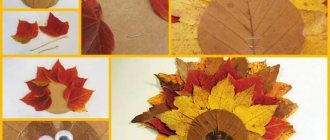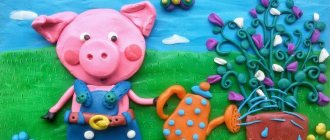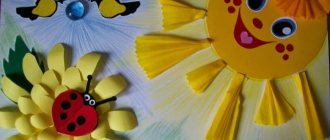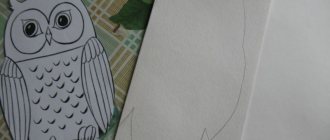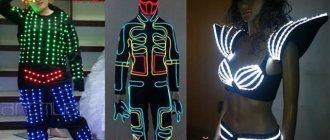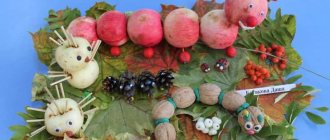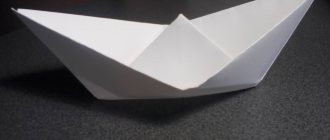A special place in children's handicrafts is occupied by work using natural materials. It’s comfortable and safe to work with, and your crafts get a natural look. The time to collect raw materials for crafts is the end of summer and beginning of autumn.
Before making crafts from natural materials, you should carefully study photos of crafts made from seeds. They are presented in huge quantities on various thematic sites.
Young children are encouraged to participate in such crafts.
The motor skills of the fingers are directly related to the child’s speech apparatus. By developing finger motor skills, children begin to speak and connect words into sentences earlier.
They have fewer speech defects and develop other abilities that will help them in adulthood.
Maple, elm and ash seeds for creativity
Unusual tree seeds are ideal as an addition to ready-made figurines. They make interesting wings and ears. You can also make the following original crafts separately from these natural materials:
- From ash seeds you can make a three-dimensional chrysanthemum or a real porcupine. To do this, plasticine is glued to a cardboard base in the shape of a circle, and the seeds themselves are glued to it.
- And maple seeds can be made into an applique in the form of a Christmas tree or unusual snowflakes. Such natural materials are very well suited for making simple crafts for the New Year.
- “Fluffy” elm seeds will be an excellent basis for creating applications with different flowers. You can use pea halves as the centers of the inflorescences. But the ash seeds themselves will become beautiful petals. Such applications can be supplemented with butterflies made from dry leaves and branches and stems.
Features of using seeds for creativity
A wide variety of crafts can be made from natural materials such as bones, seeds and cereals. From them you can make:
- appliqués: paintings can be laid out using a stencil or creating a design during the manufacturing process;
- three-dimensional figures: large elements can be connected to each other using silicone glue, small ones are usually glued with plasticine, you can also paste foam blanks with seeds and cereals;
- small decor: small natural material is suitable for gluing individual parts of large crafts or paintings, watches;
- pendants and beads: gluing seeds to ribbons or gluing them in the shape of different objects (snowflakes, Christmas trees) allows you to get non-standard home decor or original jewelry.
It is recommended to use cardboard to display pictures of seeds and cereals. Paper is of little use for such crafts, since it will bend greatly under the weight of natural materials.
DIY tools
To create a beautiful craft from natural materials, you will need additional tools and materials.
It can be:
- colored paper;
- cardboard;
- leather scraps;
- scraps of fabric;
- bird feathers;
- Styrofoam;
- plasticine;
- wire;
- PVA glue, “Moment”;
- gouache;
- stain;
- varnish, etc.
Paper is very often used as a complement to natural materials. Children, bending and gluing it, make the work much more interesting.
Plasticine is used to hold together individual parts of simple toys at the initial stage of work. It is not very durable, but as an addition it is often used in kindergarten and elementary school.
The frame of a toy and the connection of its parts are most often made from wire. Copper wire with a diameter of 0.29-0.35 mm - soft, flexible and durable - is most convenient. And for the frame, wire of a larger diameter is used - 1-1.5 mm.
It is better to take thick, multi-colored threads (No. 10).
It is better to use white PVA, BF, etc. glue. However, in kindergarten it is better to use PVA glue.
They also use foil, pebbles, cherry pits, and bristles.
It is better to store additional material in a small box with compartments for each type of material.
The use of additional material depends on the plan, the skill of the children, and the degree of development of imagination! Offer your options, but rely more on children's intuition and desire.
It is also additionally necessary to have certain tools for making crafts from natural materials:
- knife;
- art scissors;
- awl;
- jigsaw;
- tweezers;
- pliers and wire cutters;
- sewing needles;
- brushes for glue and paints;
- a cotton cloth for wiping off glue residue.
Scissors for children should have blunt ends, small, and have rings that are comfortable for a child's hand.
The awl should be made of durable material with a handle length of about 6 cm, a diameter of about 2 cm, and the piercing part is 3.5 cm.
You need a large sewing needle. Be sure to store it in a pincushion with a thread threaded into it.
Attention! Only adults use pliers, pliers, and drills!
To draw the outline of the cut part, you need a simple pencil. For example, a dress, hats for a doll, etc. It is better to take a soft pencil (2M).
It is recommended to use gouache or acrylic paints in special sets.
Brushes (soft for painting, harder for glue). It is better to buy squirrel tassels (No. 4 and 6). For glue, use brushes with hard bristles.
A stack is a tool necessary for processing a surface made of clay or plasticine. The length of the stack for children is about 12 cm. You can make the stack yourself from a worn-out brush: round it on one side and sharpen it on the other.
What crafts can you make at home?
A completely unexpected result can come from ordinary pumpkin and sunflower seeds if an interested home craftsman gets down to business. Experienced craftsmen advise starting with simple products, and only if you achieve success at a certain level, move on to the next, higher one.
This advice is especially applicable to children for whom it is important not to be disappointed in their own abilities at the beginning of their creative journey.
Hedgehog made of plasticine and seeds
Young children really like this craft, so only soft materials are used to make it. By combining various seeds, whole grain cereals, fallen leaves and plasticine, you can create a touching composition “Hedgehog in the autumn forest”.
You will need:
- seeds, including striped ones (can be replaced with cereal grains);
- plasticine of any color;
- peppercorns for the eyes.
Stages of work:
- make a shape from plasticine that resembles a drop;
- stick the nose and eyes from pepper seeds;
- insert seeds representing needles;
- decorate the finished product with grass, leaves, and a small decorative apple.
Application from maple and ash seeds
Maple and ash are trees familiar not only to rural but also city dwellers. And their seeds, which are found in abundance every year, are an excellent material for children's crafts. If necessary, you can get lionfish seeds even in winter. It is enough to dry them and use them in classes with children of different ages.
For kids it is better to choose simple plots. For example, try making dragonflies flying over colorful flowers. To work you will need a landscape sheet, multi-colored plasticine, maple and ash lionfish, and gouache.
Before starting work, say what will be depicted in the picture: how many flowers and dragonflies, how and where they will be located, and so on. In this way, the child will learn the idea of the craft, and based on the ideas received, it will be easier and more interesting for him to complete the work. For clarity, you can draw the outlines of future flowers and dragonflies with a simple pencil.
So, we’ll sculpt the dragonfly’s body from plasticine, and make the wings from maple seeds. Stick ash seeds into the plasticine center cakes with a sharp tip along the entire circumference, you will get unusual flowers. To make the picture more elegant, let’s color the flower petals. Using green paint we will draw stems and all kinds of leaves. It turns out that dragonflies are fluttering over the flowers. Perhaps the little artist will want to add to the picture. Let him draw, for example, a ladybug or a bug. Be sure that this craft will only benefit from this.
It seems like there is nothing complicated, but in order to achieve the desired result, the child will have to draw, sculpt, and tinker with natural materials. All this will require attention, perseverance, and accuracy. During the work, fine motor skills, imagination, thinking, and speech will develop. The adult’s task is to suggest, help, maintain the child’s interest in all ways, and at the end of the work, be sure to praise or even encourage him with something. The picture can be hung on the wall in the children's room or given to grandma for her birthday.
Spiny animal from seeds
Autumn time generously gifts us with a wide variety of fruits of nature. To make a hedgehog from seeds you will need a small pumpkin, a sheet of thick cardboard, dry yellow carved maple leaves, sunflower seeds and multi-colored plasticine.
The pumpkin fruit should be cut in half, remove the insides and clean the outer surface of dust. The tail of the pumpkin should be trimmed with a knife. Now this part of the fruit needs to be given the shape of an animal’s muzzle.
Using a special spatula, a layer of plasticine is applied to the outer surface of the pumpkin to attach the sunflower seeds.
A muzzle with eyes made of black peppercorns and a round nose made of plasticine is formed. The rest of the surface is covered with dry black sunflower seeds.
On the surface of a cardboard sheet you need to secure several maple leaves with glue and place a figurine of a hedgehog made from sunflower seeds. Such a craft can qualify for a prize in the craft competition of a preschool kindergarten.
- How to sew a decorative mini bag with your own hands
- Crafts from cotton pads - beautiful ideas and tips on how to make decorations and toys with your own hands (70 photos)
- DIY New Year's crafts: 70 photo ideas and a master class on making crafts for the holiday
Autumn gerberas from maple lionfish and plasticine. Master Class.
Autumn gerberas from maple lionfish and plasticine. Master Class.
Bright, unusual gerberas from maple lionfish can be made with middle and older children. The manufacturing technology is very simple. Children will enjoy doing this during class. The simplest techniques for working with plasticine and natural materials will allow your children to do this kind of work. This type of work develops fine motor skills, dexterity, imagination and artistic taste.
For work we will need:
- maple lionfish,
- plasticine,
- wooden skewers or twigs,
And most importantly - a good autumn mood.
Roll plasticine balls, then flatten them and insert maple lionfish. We place the lionfish close to each other (it is important that their direction coincides)
These are such wonderful flowers.
Now let’s paint our flowers in our favorite color.
Our gerberas are ready.
We wish you good luck and creative ideas!
How to paint seeds
Photos of crafts made from seeds once again prove that it is not necessary to leave the natural color of the material used. In addition, the seeds are easy to color, why not take advantage of this?
- If you need to paint several seeds, you can do this separately with each one.
- If you need to paint a lot of seeds at a time, then the material is poured into a bag, acrylic, gouache or food paint is added, mixed and left to soak for a while.
- If seeds are used in appliqué, they are often painted upon the finished work.
In any case of painting, it is worth remembering that the paint and seeds must dry well.
Lionfish helicopter
This craft is a little more complex, and therefore the process of making it will be more fun. In addition to maple seeds, we will need material for the helicopter body. A chestnut or walnut, or a peach pit, would be suitable here. Without them available, you can make the body entirely from plasticine.
The first step is to sculpt the main part of the helicopter. If you are using a nut, then stick plasticine on it to form a body. Next we make the top and rear blades, attaching the winglets to the cockpit. The helicopter will also need windows and landing gear. They can be made from plasticine.
Owl with seed plumage
To make an owl you will need a piece of foam plastic. It needs to be given an ovoid shape and covered with a thin layer of plasticine. Place two circles of seeds in the upper part - these will be the eyes of the owl. You can mold black and white pupils in the center or use ready-made eyes from handicraft stores.
We decorate the rest of the space with seeds, placing them in one direction. This is the plumage of an owl. One of the seeds should be painted yellow or orange - this will be the beak. The owl is ready.
Note!
- How to make a rose from paper - the best ideas for DIY crafts + master classes on creating a rose from paper (160 photos)
- Craft letter - TOP 120 photo reviews of craft letter. Simple diagrams + step-by-step DIY instructions
- Crafts made from nut shells: the best step-by-step master classes on creating DIY crafts with photo examples of finished works
Applique from maple lionfish for preschool children step by step with photo
DIY lionfish applique. Master class with step-by-step photos.
Master class using step-by-step photos “Dragonfly on a flower.”
Description: Master class for preschool children, intended for kindergarten teachers, additional education teachers, and parents.
Purpose: The applique can be used to decorate a home or exhibition.
Goal: To form imaginative thinking and creative imagination through the transfer of the characteristic features of the depicted object.
Tasks:
- Strengthen the skills of manufacturing and processing the surface of a mold using various techniques and methods;
- Develop fine motor skills, imagination and imagination while working on the expressiveness of the image of a dragonfly or flower;
- Cultivating interest in knowledge of living nature and caring attitude towards it;
- Fostering accuracy and a rational approach to the use of materials.
Materials for the lesson: On the TV panel there is a photo with an image of a dragonfly on a flower, photographs depicting the sequence of work on the application, a sample of work, dried maple seeds (lionfish), scissors, a sheet of A-4 paper, plasticine. “Dragonfly on a flower” Riddle about a dragonfly:
“A helicopter landed on the daisy at the gate - Golden eyes. Who is this? (Dragonfly)
Step-by-step process for making an applique:
Materials and tools for work.
We construct a core for the flower from a plasticine ball and plant it in the middle of the circle. We stick the lionfish with its sharp end into a plasticine circle.
We place the lionfish tightly to each other along the entire diameter of the circle. If desired, you can lay out the lionfish in a second circle. We roll out the body of a dragonfly from a plasticine sausage and from two small balls-eyes. We stick two lionfish on both sides to the dragonfly’s body. These are wings. We plant a dragonfly on a flower. The work is ready!
Decorating the room with paintings and applications
Following step-by-step instructions for making crafts in the form of appliques and paintings using pumpkin and sunflower seeds, you can achieve impressive results without much difficulty. You should start by finding a sketch that satisfies you and purchasing the necessary seeds and paints. Cardboard or durable paper is used for the base of the products. The source material is fixed to the base using PVA glue. In some cases, a hot glue gun or silicate glue is used.
Crafts from leaves and maple “helicopters”
The easiest and most accessible job, even for kids, is leaf applique. If this is your first time making a composition with your child, offer him a picture that will serve as a template. Don't rush to do everything yourself. Invite your child to choose leaves as desired so that the work turns out similar to the sample. This will develop your child's creative abilities.
Material for application:
- colorful leaves;
- thick sheet A-4;
- glue brushes;
- PVA glue;
- scissors;
- sample.
To make a simple arrangement, you need even, dry leaves. Place them under a press or in a book. In two days the material is ready. Cut out the appropriate pieces with scissors and lay them out on a sheet of paper.
Now you can glue it. First the background and lower layers, and then the finer details. For example, if you want to make an elephant, then first make a body and head out of leaves, and then glue on the trunk, tail, and legs. If you don’t have enough eyes, you can add them in with a marker or make them from tree seeds.
You don't have to do everything according to a template. You can come up with a picture yourself and create an original composition from leaves.
Use colored paper, felt-tip pens, and paints as an addition, so your applications will be even more interesting.
Along with leaves, maple “helicopters” are also ideal as a basis for crafts made from natural materials for kindergarten. Just look at this miracle!
Fairy wings made from maple seeds
Dragonflies from maple "helicopters"
Now you have seen how beautiful and original leaf applications can be. Use these ideas for spending time with your children.
Watermelon seeds
Small watermelon seeds are more suitable for laying out various applications. For example, using such natural material you can make the following crafts:
- Application "Cheburashka".
Cheburashka is drawn on a white sheet of cardboard. Its body and ears are sealed with watermelon seeds. You can use black peppercorns as eyes or make eyes from black plasticine.
- Painting "Peacock".
A peacock is drawn on a white sheet of cardboard. The stripes dividing its tail into feathers are lined with watermelon seeds. You can stick pine cone scales or beans on the ends. The remaining “empty” elements of the picture are simply painted.
- Unusual kitchen clock.
The old kitchen clock is disassembled into individual parts. The base (into which the clock mechanism is inserted) is covered with seeds. An indication is cut out of golden paper and pasted over the seeds. The watch is assembled in reverse order.
Crafts from maple parachutes for children: photos
Important: The imagination of creative people is limitless. In the process of creating crafts, not only maple leaves are used, but also parachutes, or earrings, they are called differently.
Craft “Dragonfly”
A very simple craft that even the little ones can handle (with the help of their mother, of course).
Dragonfly from maple parachutes
For production you will need:
- Maple parachutes
- Paints
- Brush
- Glue
- small twig
Paint the parachutes with paints, then let the paint dry. Then glue the parachutes onto the branch. The craft is ready!
You can make a whole collection of colorful butterflies, dragonflies and other insects this way.
Insects from maple lionfish
Crafts from maple parachutes
Applications from maple seeds
It's easy to make a hedgehog from maple seeds. Draw a hedgehog on a piece of paper; you can also print the finished picture. Instead of needles there will be maple parachutes.
Hedgehog from maple seeds
In addition to the hedgehog, you can make any other applique. For example, an owl.
Owl from maple seeds
What seeds are used in creativity?
Seed material is divided conditionally into the following groups:
- cereals; always available in sufficient quantities, colorful;
- pumpkin and sunflower seeds; also easy to find; successfully used for large-scale work;
- seeds of deciduous trees (ash, maple, birch); often accumulated after themed walks and can later be used in crafts;
- legumes (lentils, peas, beans) can add bright colors to your work;
- coffee beans - suitable not only for decoration, but also for flavoring the room.
Separately, it is worth mentioning nut shells and cones. In the design of works they are used both as a whole and in separate pieces.
Owl made from natural materials - master class
I simply drew the template for the owl by hand. This is what he looked like.
I transferred it to the back side of the cardboard, simply tracing it with a pencil.
I cut it out with scissors clearly along the drawn outline and I got something like this.
Now about maple seeds. Unfortunately, I do not understand the correct botanical names of plants, so I cannot accurately say the names of the trees from which these seeds were collected. I know for sure that these are some types of maple. All our lives we have called these maple seeds “helicopter seeds” for their ability to spin as they fall, much like a helicopter propeller. So, my children and I collected these two types of “helicopters”. Both of these types are required.
These narrower and straighter ones will serve as the plumage of the owl’s body.
But these - large, wide and curved towards the top - will replace the feathers of the wings of our owl.
The kids sorted the seeds for me into two piles so as not to have to sort through them for a long time during the gluing process, since I used hot glue, which hardens very quickly. I started making an owl by gluing “feathers”—seeds—to the owl’s body. To do this, I applied a strip of glue and glued narrow “helicopters” onto it, but not just like that, but observing the direction of their “wing”. They seem to have to look to the center, to the left, to the right.
The direction of work goes from bottom to top.
Above the previous row, at a short distance, she repeated the same thing.
And in the same way she filled the owl’s entire body with “feathers”.
When the body was “dressed”, she moved on to the wings, taking wide curved seeds for them. I also used hot glue for gluing (be careful, you may inadvertently burn yourself). Only all the seeds on one wing are directed in one direction.
The second wing is also only the seeds are directed in a mirror way.
When the wings and body are ready, you can “tackle” the head. First I made the beak. To do this, I cut out this shape from yellow felt, slightly reminiscent of a triangle.
When I made the first owl, I cut out the beak from velvet paper. But I didn't really like this option because the paper was stiff and it was difficult to bend it nicely. This time, having taken felt, I realized that I was not mistaken in choosing this material. I made the beak quickly and easily by rolling it into a “ball” and gluing the joint.
The beak was glued to the owl's head.
I did the following steps quickly until the glue hardened, so I didn’t take separate photos. First I glued the button eyes, around them there were like “glasses” made of pea seeds. I smeared the rest of the space with glue and simply poured in a handful of buckwheat, and when the glue hardened, I shook off everything that didn’t stick. The result is this “face” of an owl.
I finished it all off with one small touch - I glued two maple seeds above the eyes to create “eyebrows.”
My daughter happily took such an owl made from natural materials to a school exhibition of crafts made from natural materials. Try making this craft with your children yourself.
Materials for creating your own applique
List of materials needed to create an applique at home
- Maple earrings;
- Foamiran brown;
- Eyes;
- Scissors;
- Plasticine yellow;
- Buckwheat and lentils;
- Owl template;
- Glue gun.
Autumn crafts from vegetables and other natural materials
Pumpkin UFO
That’s right, from a pumpkin you can make not only a carriage for Cinderella, but also a vehicle for aliens. To make this autumn craft you will need toothpicks, garlic, carrots, leaves, viburnum and plasticine. Small heads of garlic are turned into interesting aliens with the help of plasticine, and carrots are turned into UFO legs. Encourage your child to come up with their own details - you'll be surprised how creative the new generation is.
Pumpkin vases and baskets
Both we and our parents made such autumn crafts with our own hands. The scope for imagination is vast. Flowers, leaves, berries, fruits and other vegetables are suitable for making the composition. If you try hard, you will get not just an exhibit for an exhibition, but a wonderful decorative element.
Animals made from nut shells
You will need whole walnut shell halves, paint and patience. The result is worth it. Such animals look great in a clearing with moss - another classic autumn craft for kindergarten or school.
Even more ideas for autumn compositions
Cauliflower can be fried. Or you can make sheep or poodles out of it for a school exhibition. Take a closer look at eggplants - don't they remind you of penguins? A zucchini will make a wonderful vase or boat. Amazing things are nearby. Imagine!
1 of 10
source
Preparation of natural materials for their further use
Nature is the best artist; she creates natural materials that, in skillful hands, turn into works of art!
It is better to collect leaves in the fall, when they are especially beautiful. Leaves of oak, maple, and chestnut can be used to create all kinds of applications:
Birds made from leaves
Insects from leaves
The shells of these snails are made according to the principle of assembling a rose from leaves:
Examples of other leaf applications:
Wreaths made of bright leaves are the most atmospheric autumn decor!
This option for assembling a wreath is much simpler than the previous one - even children can handle it:
For long-term storage, the collected leaves are placed between paper sheets and ironed with a warm iron. Then they are laid out with old newspapers, thin cardboard and pressed down on top with a small weight.
Preparing material for work
Before you start creating autumn crafts from seeds, it is worth preparing the material:
- The seeds are thoroughly washed with water
- Then they are allowed to dry - this is a mandatory procedure, otherwise they may become moldy over time.
- If required, the seeds are painted with acrylic paints
- After the dyeing procedure, it is thoroughly dried again, after which the material is ready for use.
Noses like wings
While walking through the forest with your children, collect maple seeds - “spouts”, thin sticks and some leaves. We will make interesting and simple crafts from them. Children of all ages enjoy crafting from natural materials. Let's help the little ones, right? Who would have thought that maple lionfish are so similar to the wings of a dragonfly or moth. Especially if you paint them with gouache. Having made one craft, you want to try again, because despite the simplicity of execution, it turns out very expressive and interesting.
We will need: maple “spouts”, thin twigs, beautiful fallen leaves, toothpicks, gouache, a brush, a jar of water, plasticine
Making a blank for a dragonfly. Cover the stick with plasticine and attach a small ball to it.
We paint the maple “noses” - these will be the wings.
Attach the wings to the stick and get a dragonfly.
We make a similar preparation for the bird.
Once you've attached the wings, don't forget the tail! This is such a wonderful bird.
Using the scheme you already know, you can make any flying creature. Only the shape of the head and body will differ. I decided to add a moth to accompany the dragonfly and bird.
Crafts made from natural materials are a very exciting activity. Have a good mood and let your imagination run wild!
Noses like wings. After a walk through the forest While walking through the forest with your children, collect maple seeds - “spouts”, thin sticks and some leaves. We will make interesting and simple crafts from them. Children of all ages enjoy crafting from natural materials.
Maple, elm, ash seeds
A ready-made set of small cones for crafts.
Maple seeds - “spouts” - are interconnected and easily separated from each other.
The bright green seeds dry out and take on a beige hue.
Elm seeds are round, transparent, with a brown center.
Ash seeds are light brown in color and resemble an elongated droplet in shape.
Ideas for children's crafts made from sunflower seeds
Real museum pieces
Paintings and panels made from seeds are masterpieces of handicraft. They easily become a decoration in any home, easily fit into any interior, giving a unique charm and elegance. Without knowing how the picture was created, no one at first glance can imagine that these are simple seeds and cereals. In the skillful hands of the master, they turned into an original decorative element.
Crafts made from seeds are not expensive. Since the seeds of the fruit are used for work, which after eating are sent to the trash bin. And some can be bought in a store or market for little money. A bottle, a coffee can, an ice cream cup and much more can get a second life. For example, a decorated coffee can can become an organizer for pencils and pens or a container for storing all sorts of small items.
Amulet made from seeds
Another type of handicraft that allows you to receive not just a souvenir or decoration for your home, but an object, a gift with deep meaning. Suitable for those housewives who want goodness, good luck and prosperity to settle in their home. You can buy a ready-made amulet, or you can make it yourself. The most common one is a broom with a certain set of seeds and items. In the culture of many nations, the broom is a symbol of protection against evil forces entering the house.
For example, the presence of sunflower seeds on the amulet protects the health of children and the energy of the sun. Each craftswoman fills her panel with the necessary components (for her, her family, or the person to whom it will be presented). Therefore, if you are planning to create your own amulet, you need to know and understand which element should be added and which should not.
Recommendations for working with seeds
In the second half of summer and autumn it is necessary to harvest seeds. They need to be washed well and dried. Then place it in a storage container; do not mix different types, as it will be harder to work with them.
The work itself begins with searching for the surface that will be decorated and in what way. Sunflower seeds look very good in images of birds and animals. For example, a hedgehog made from seeds, it can be in the form of a figurine or a picture. For the first option you need: a handful of seeds, a piece of plasticine and a little imagination. A pear-shaped blank is molded from plasticine - the body of a hedgehog. Then, starting from the middle of the workpiece, we stick in the seeds, immersing about half of them in plasticine. Almost everything is ready, all that remains is to make the nose and eyes and the hedgehog is ready. It can be placed in a forest clearing, in the company of other animals, it all depends on your imagination. If this is a painting, then you will need a background - cardboard, a sheet of paper, glue, a brush.
Sunflowers and dahlias. To create them you will need:
- sunflower and pumpkin seeds;
- PVA glue;
- CD, used or unwanted;
- white paper (thick);
- paints or gouache (preferably acrylic);
- glue gun or super glue;
- scissors;
- colorless varnish.
The disc must be covered with white paper. Then, after complete drying, pumpkin seeds are glued around the perimeter. The next step is to paint them yellow. You need to place sunflower seeds in the middle. The flower is ready. A dahlia flower is created using the same principle, only one type of seed is used and at the end it is covered with paint of the chosen color. There are a lot of ideas.
How to Preserve Autumn Leaves for Crafts
- The traditional option is to dry the leaves between the sheets of a notebook or book. A weighting material should be placed on the top of the book. This method is suitable if you have a small amount of material. Leaves should not be stacked too often, as this will ruin their shape and they will dry out and become uneven.
- Use an iron - place clean paper on both sides of the sheet and iron the material. Be sure to place something hard under the sheet if you use the iron on the ironing board. The leaves will quickly become flat and dry.
- Paraffin will help - melt a candle on the stove, when the wax is liquid - dip a leaf into it. Then take it out, turn it over and do the same with the other side. Remove and tilt so that excess paraffin remains in the container. Place the material on a newspaper or sheet to harden the wax. Make sure that the paraffin does not boil and is not too thick.
- Preservation in glycerin - make a solution of glycerin and water (1:2) and leave the leaves in it for 2 days. The leaves will acquire a greasy sheen, but will successfully retain their shape and will be useful for crafts.
Fairy craft "Autumn"
Making an autumn landscape craft with your own hands is easy and simple. To do this you need to show a little imagination. Find unnecessary items at home to make a craft with your own hands, perhaps broken children's toys, dusty on shelves or closets. Fabrics, threads, needles, paper clips. glue. cardboard is everything you need for your work.
Completely finished craft from an old doll
Usually, toys usually contain broken dolls without legs; do not rush to throw them away; this is the most necessary thing for making a craft “Autumn Fairy” doll.
We take an ordinary plastic bottle, cut off the bottom and neck of the bottle. to insert the doll's body into the bottle. The bottle itself serves as the frame of the dress.
We cut maple leaves from raincoat fabric according to a template or buy ready-made ones. The number of leaves depends on the height of the doll.
It is necessary to add volume to the dress; we use cardboard. We cut the cardboard itself into a cone shape and glue it with glue. You can also secure it with a stapler.
We create a dress from leaves in layers. down up. Next, we decorate with various ready-made dummies of fruits, cones, and twigs. If necessary, you can use various decorative stickers, of which there are now a huge number in stores.
You can make an autumn craft from an old doll with your own hands in one free evening. This craft is suitable for schools and kindergartens, various competitions. and also as a personal hobby.
Autumn craft umbrella made from leaves, details with photos
Material:
- Old children's umbrella
- Thick threads (twine)
- Autumn themed leaves and decorations
- Needle and thread
Progress:
- Remove the fabric from the umbrella. Tie it in a circle with twine, trying to leave as few gaps as possible.
- Make a garland of leaves and fall material by stringing them on a string.
- Place the garland on the umbrella. For strength, sew the leaves to twine.
Fairy craft "Autumn"
Making an autumn landscape craft with your own hands is easy and simple. To do this you need to show a little imagination. Find unnecessary items at home to make a craft with your own hands, perhaps broken children's toys, dusty on shelves or closets. Fabrics, threads, needles, paper clips. glue. cardboard is everything you need for your work.
Completely finished craft from an old doll
Usually, toys usually contain broken dolls without legs; do not rush to throw them away; this is the most necessary thing for making a craft “Autumn Fairy” doll.
We take an ordinary plastic bottle, cut off the bottom and neck of the bottle. to insert the doll's body into the bottle. The bottle itself serves as the frame of the dress.
We cut maple leaves from raincoat fabric according to a template or buy ready-made ones. The number of leaves depends on the height of the doll.
It is necessary to add volume to the dress; we use cardboard. We cut the cardboard itself into a cone shape and glue it with glue. You can also secure it with a stapler.
We create a dress from leaves in layers. down up. Next, we decorate with various ready-made dummies of fruits, cones, and twigs. If necessary, you can use various decorative stickers, of which there are now a huge number in stores.
You can make an autumn craft from an old doll with your own hands in one free evening. This craft is suitable for schools and kindergartens, various competitions. and also as a personal hobby.
Butterfly craft from autumn leaves, detail with photo
Materials:
- Autumn leaves
- Double sided tape
- Scissors
- Glue
- Hole puncher
Progress:
- Cut off the top and stem of maple leaves. The middle will remain for the butterfly wings.
- Attach a small leaf to a small strip of double-sided tape, which will serve as the butterfly's head.
- Attach the upper and lower wings of the craft to the tape.
- At the end, glue an oblong piece of paper that will be the belly. Make antennae from the stems of the leaves and glue them to the head.
- Using dry sheets and a hole punch, make eyes and a pattern of circles on the butterfly, secure with glue.
